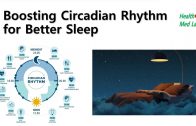Boosting Circadian Rhythm for Better Sleep
#sleep #insomnia #circadianrhythm
@HealthMedLab63
BGM outro
@TimelessPianoKeys
The circadian rhythm, governed by the suprachiasmatic nucleus and influenced by peripheral clocks throughout the body, is a deeply embedded biological system that orchestrates an array of physiological and behavioral processes. Central to this orchestration is the interplay between light and darkness, as well as other time cues like meal timing, physical activity, and social routines. When these daily signals are aligned with natural day-night cycles, the human body operates in a state of remarkable harmony, leading to improved sleep quality, better mood regulation, and optimized cognitive and metabolic function.
However, contemporary life often presents numerous challenges to maintaining this alignment. Artificial lighting extends the day far beyond sunset, digital devices deliver constant stimulation, and professional and social obligations frequently disrupt consistent schedules. The result is a widespread disconnect from the rhythms our bodies evolved to follow, manifesting in widespread insomnia, fatigue, and other health disturbances.
Fortunately, the path back to circadian balance is accessible through daily, practical strategies. Purposeful morning light exposure works as a reset button each day, synchronizing the SCN with the external environment. Regular meal times, thoughtfully spaced throughout the day, help align peripheral clocks in the liver and digestive system. Physical activity bolsters wakefulness cues, while mindful avoidance of excessive nighttime light preserves melatonin secretion. Ensuring a cool and comfortable sleep environment, practicing stress management, and keeping consistent bed and wake times all further stabilize the rhythmic underpinnings of healthy sleep.
Each of these interventions is empowered by a clear physiological mechanism, illustrating why these small habit changes can have such a large impact. Whether it’s the direct influence of bright light on melanopsin-rich retinal cells, the role of meal timing in calibrating peripheral clocks, or the temperature-mediated facilitation of sleep onset, every strategy is rooted in our intrinsic biology. By understanding these underlying mechanisms, individuals become more motivated to implement and maintain habits that can bring about genuine, long-lasting improvements in sleep quality.
Ultimately, reinforcing one’s circadian rhythm requires consistent and deliberate effort. It is a lifestyle shift, not a quick fix. Yet the beauty of this process is that it is both natural and sustainable, tapping into evolutionarily conserved pathways that are already present within each of us. The circadian rhythm is a testament to the delicate interplay between our bodies and the environment, a dance of light and darkness, activity and rest, nourishment and fasting. By rejoining this dance, we return to a state of equilibrium that not only grants us deeper and more satisfying sleep, but also supports every aspect of our health and wellbeing.
In a world that often pushes against natural boundaries, choosing to nurture and respect our internal clocks can be an act of profound self-care. With gradual changes—waking to the sunrise, eating meals during daylight hours, winding down with low light, and prioritizing consistent bedtime rituals—we remind our bodies that day is for energy and creativity, while night is for rest and renewal. In doing so, we rediscover a sense of alignment and vitality that is all too often lost in modern life, finding that the key to better sleep was within our own rhythms all along.
@HealthMedLab63


























